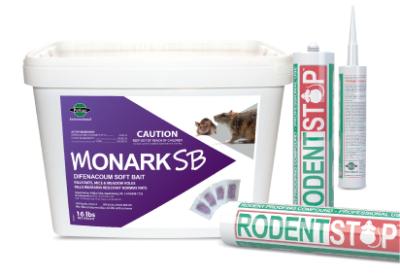
Proofing and exclusion work is essential to ensure that you don’t simply remove one colony of rodents ready for the next to move right in! Mice can squeeze through a hole the size of your little finger (or a US dime) and rats through a hole the size of your thumb (a US quarter)… finding these points of entry is much easier in a clean environment, so make sure you have a good tidy up first. Some points of ingress will be obvious, especially around doors and windows, but pay special attention to parts of the building where joists, pipes and cables enter and leave; any holes made to accommodate these are easy access for rodents. And don’t forget sewers, even small pipes are a rodent super-highway.
- Repair leaking taps and pipes inside and out to deny rodents water.
- Proof drainage and sewer pipes by fitting grilles, flaps, crushed wire mesh or other suitable materials.
- Seal the bottom of doors, especially if they have been chewed, with metal kick plates and make sure they are kept shut.
- Check all windows are maintained and do not provide easy points of entry.
- Pay attention to broken roof tiles, brickwork and foundations as these provide easy access into loft and cavity wall space.
- Make sure all foodstuffs are kept in rodent proof containers, or proof the containers they are in, and ensure any spills are cleaned up immediately.
- Seal any gaps, cracks and holes in wood, brick, PVC or metal with PelGar’s unique RodentStop exclusion product which provides a permanent barrier that rodents cannot gnaw through.
- Make sure your customer understands the importance of avoiding the creation of rodent access routes and harbourage when they are moving things around or undertaking maintenance and building work.
- If you are tackling a large infestation consider leaving a well-used, easily accessible rodent ingress point available to make baiting easier.
Proofing and exclusion work may be costly and require frequent maintenance, but good housekeeping and building upkeep should be everyone’s priority as a lack of such is precisely what invites pests – it is far easier to prevent an infestation than eradicate one.
How much rat bait is enough?
Under-baiting is a common mistake that can lead to a false conclusion that the rats are bait shy or even resistant. So here are PelGar’s simple guidelines to follow:
Low infestation - rodents only seen or heard at night and only small, but significant, damage by gnawing. Few droppings evident and only a few active burrows:
- High LD50 bait (eg difenacoum) use 7oz every 30 feet
- Low LD50 bait (eg brodifacoum) use 2oz every 30 feet
High infestation - rodents often seen in the daytime, conspicuous damage to property and goods by gnawing. Abundant droppings, runways evident and many active burrows:/p>
- High LD50 bait (eg difenacoum) use 7oz 15 feet
- Low LD50 bait (eg brodifacoum) use 2oz 15 feet
Tackle large populations by increasing the number of bait points, not the amount of bait within them. This helps get bait to more rodents quickly and efficiently but it is not simply a case of over baiting to achieve quick results, as this will adversely impact non-targets and the environment - and be a wasted cost for you and the customer.
Keep on top of your inspections to record the amount of bait put down, so you can follow the patterns of activity to assess what’s going on at the site. Be aware that it can take some time to overcome the neophobia with rats. Keep baiting until all feeding activity has stopped.
If bait take is still low after a couple of weeks but recent activity is evident then it’s time to relocate the bait stations to an area of higher activity and check that your proofing work is driving rodents towards the bait.
If you find that bait take is substantial over a long period consider whether non-target animals are consuming the bait or an immigrant population has moved in. Check through your proofing and exclusion work to resolve these issues. Only if neither of these are occurring can resistance be suspected.

